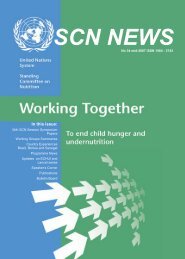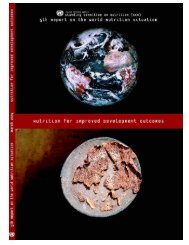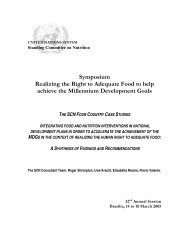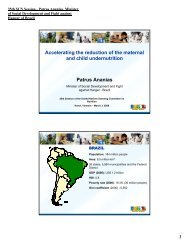Universal Salt Iodization (USI) - FTP Directory Listing
Universal Salt Iodization (USI) - FTP Directory Listing
Universal Salt Iodization (USI) - FTP Directory Listing
- No tags were found...
Create successful ePaper yourself
Turn your PDF publications into a flip-book with our unique Google optimized e-Paper software.
26FEATURESwww.unsystem.org/scnIn an extensive review of the more than 80 year–old iodized salt programme in Switzerland, Bürgi shows the roles ofsalt industry, the Swiss Federal Government and other stakeholders, in addressing IDD (Bürgi 2005). After having observed,at the regional level, the positive effects of salt iodized at 7.5 ppm iodine, the Federal Government created theSwiss Goitre Commission in 1924, which was later succeeded by the Fluorine-Iodine Commission of the SwissAcademy of Medical Sciences. This Commission is a non governmental body made up of public health officials,medical and food experts, and salt manufacturers. It advises on the iodine content in salt. As existing levels wereobserved to be ineffective, the Commission raised the recommendation from 3.75 ppm in 1924 to 20 ppm in 1998. TheCommission meets regularly to review data on developments in iodine nutrition and iodized salt production and makesproposals for the Federal Commission of Nutrition. The introduction of the salt iodization programme and cooperationof all the partners in the Commission has resulted in sustained success. Although it operates on a voluntary basis andmanufacturers must offer both iodized and non iodized salt, 94% of households and 50% of processed food is iodizedat 20 ppm.The history of iodization programmes in The Netherlands is summarized in Table 1. Though not as structured as inSwitzerland, cooperation between government, health and food authorities and the Dutch salt industry has resulted insuccessful adaptations of salt iodization programmes when needed. In the 1980s an observed decline in bread consumptionin favour of bread replacements and cerealsaffected iodine nutrition in the population, in particulargirls and young women, and goitre reoccurred.Following simulation studies on consumptionpatterns and iodine intake, the authorities decided toincrease the iodine level in bread and table salt, andto permit use in other food products from 1997. Thesalt industry has been consulted on the consequencesof changes in iodine levels and iodinesources. In 2001 the effects of the adaptation of thesalt iodization programme have been published in astudy that i.a. concluded “IDD no longer exists in TheNetherlands” and “bread consumption remains themain source of dietary iodine” (Wiersinga et al 2001).Box 1: Country examples of salt iodization in partnership with salt industryTable 1: <strong>Iodization</strong> programmes in the Netherlands1928 start production iodized table salt (3-8 ppm)1932-1941 regional iodization of drinking water1942 bread salt iodized1968 compulsory iodization of all bread salt (35 ppm)1974 discontinuation of iodization of table salt1981 iodized bread salt (45 ppm)1982 reintroduction of iodized table salt; voluntary (25 ppm)1984 use of iodized bread salt on voluntary basis1997 iodized salt for bread and bread replacements (70-85 ppm),for meat products (20-30 ppm), for table salt (30-40 ppm)1997 iodate is also permitted as iodine sourceKenya, a large salt producing and exporting country with four large salt producers supplying most of the edible salt,started IDD control through salt iodization at 20 ppm iodine in 1970. The iodine content has subsequently beenincreased up to the current level of 100 ppm, which should cover anticipated losses of iodine during transportation andstorage. A recent survey (Bürgi, 2007) concluded a/o “Overall, the iodine deficiency situation has much improved overthe past 30 years and reaches a stage where Kenya could join the list of countries declared free of iodine deficiency”.This success could only have been achieved through continual collaboration between salt producers, governmentalauthorities, scientific groups and development agencies.The efforts to address IDD in Peru, have been reported in the IDD Newsletter over the years (Pretell 1998, 2003). Tocorrect severe iodine deficiency problems in the country, intersectoral collaboration was essential. Under the responsibilityof the Ministry of Health, active participation of many other sectors, notably salt producers, the media, healthprofessionals, educators, local governments, and other ministries has been crucial to the success of the National IDDProgram, which was created in 1983 and implemented in 1986. By 1996, household access to iodized salt hadreached 90%. Part of the Program was an aggressive increase in the production of iodized salt, with one large saltproducer supplying about 75% of the country’s demand, with the remainder supplied by about 40 medium and smallproducers.The situation in Indonesia reflects just how crucial and also how difficult is the role of small salt producers in achieving<strong>USI</strong>. <strong>Salt</strong> iodization in the country started under Dutch rule in 1927, but stopped in 1945 when the salt monopoly wasdisbanded. Efforts to combat IDD began again in 1976 with UNICEF support but were not successful due to lack ofaccountability and coordination among the ministries involved and the private sector (World Bank 2001). TheIndonesian government embraced the WSC goal in 1990 and a Presidential Decree enacted legislation on <strong>USI</strong> in1994. However in spite of the considerable effort and investment by the World Bank and UNICEF since then,household use of adequately iodized salt, which initially increased from 50% in 1995 to about 73% in 2003, hasremained stable in the last years. The major challenge is that non iodized salt is reaching consumers through directsales from farmers or traders (UNICEF 2003). Further increase of household coverage will require additional creativeefforts on the part of all partners involved and may necessitate new variations of partnerships. One recentlyinvestigated option to prevent leakage of non iodized salt into the market by small producers is manual iodization ofraw salt, which does not require investing in upgraded salt or iodization equipment (Tanduk et al. 2006).SCN NEWS # 35 back to contents







